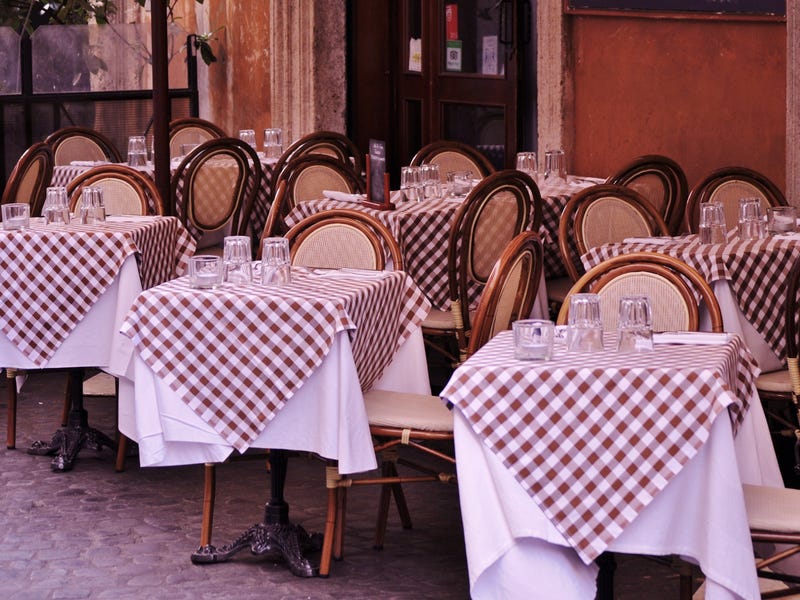Definite and indefinite articles in Italian are small words that pack a big punch. Sure, understanding and knowing how to use them will bring you one step closer to tackling Italian grammar. But they can do so much more than that!
These small words can also help you order something correctly in a restaurant, talk about specific things that you want, and generally: help you feel more confident when speaking with Italians.
You should also think of the definite and indefinite articles as the building blocks of the Italian language. Having a strong hold on them can also unlock other exciting grammatical features of the Italian language, like partitive articles and contracted prepositions. Don’t worry, they’re not as complicated as they sound, I promise!
In this article, you will find:
- Explanations on the differences between definite and indefinite articles in Italian
- Helpful vocabulary examples and translations for each article
- Partitive articles and contracted prepositions and how to use them
- Special cases that don’t require use of the definite and indefinite articles
Andiamo!
What are articles in Italian grammar?
In total, there are eleven definite and indefinite articles in Italian. They come before nouns and demonstrate the gender of a noun and whether or not it’s singular or plural.
This concept can be a little tricky for an English speaker. Just remember that in Italian, a noun can be modified based on its gender or number. And it’s crucial that the noun’s preceding article agrees with its gender and number.
Let’s start by looking at indefinite articles!

What is an indefinite article in Italian?
Simply put, an indefinite article in Italian is an article that refers to something unspecific or unidentified. In English, there are two: a or an. They come before a noun, and refer to general, unspecified things.
There are four indefinite articles in Italian:
- Two masculine forms → uno, un
- Two feminine forms → una, un’
When and how to use indefinite articles in Italian
So, when do we use them?
- When you’re talking about something general or unspecified. Imagine that you’re traveling through Puglia by car and you want to spend the day at the beach. In this case, you don’t have any specific beach in mind…you’re up for going anywhere! You decide to ask the hotel’s concierge for advice. In this case, you would say something like: Sto cercando una spiaggia qua vicino. → I’m looking for a beach nearby.
- When you’re talking about something for the first time. Now imagine that you’ve met someone special during an aperitivo, and you want to tell your friends about them. You might start this conversation with something like: Ho conosciuto una ragazza / un ragazzo. → I met a girl/a guy. And then you’d gush about your new crush and spill all the details.
Now we need to understand how to use (and decide between) the four indefinite articles in Italian.
- Gender: First, narrow down your options by asking this question: Is the noun masculine or feminine? If it’s masculine, your options are uno or un. If it’s feminine, your options are una or un’.
- The first letter (or two) of the noun: There are a few rules to remember when it comes to the starting letter(s) of the words. You’ll find the explanations in the tables below, but basically:
- If your noun is feminine and starts with a vowel, you must use un’. Other feminine nouns starting with a consonant will take una.
- If your noun is masculine and starts with a vowel or consonant (except for s + consonant), it takes un. The other masculine article, uno, is used with certain letters and groupings, which you’ll find in the table below.
Singular masculine
Here are the two masculine indefinite articles in Italian. Take a look at the specific consonants and clusters that require uno!
Article: Uno
When is it used?
Before words in the masculine singular form starting with:
- s + consonant
- z
- x
- pn and ps
- gn
- i or y followed by another vowel
| Examples | English translation |
| uno scandalo, uno studio, uno specchio | A scandal, a study, a mirror |
| uno zio, uno zucchero, uno zaino | An uncle, a sugar, a backpack |
| uno xilofono, uno xilografo | A xylophone, a xylograph |
| uno pneumatico, uno psicologo | a tire, a psychologist |
| uno gnocco, uno gnomo | a dumpling/fried dough, a gnome |
| uno yogurt, uno iettatore | a yogurt, a jinx |
Article: Un
When is it used?
- Before words in the masculine, singular form starting with a consonant (except for s + consonant, which takes uno) or vowel.
| Examples | English translation |
| un fiore | a flower |
| un cane | a dog |
| un libro | a book |
| un topo | a mouse |
| un fazzoletto | a handkerchief |
| un tappeto | a carpet |
- Before words from the English language that are commonly used in Italian (like weekend and whiskey)
| Examples | English translation |
| un albero | a tree |
| un alfabeto | an alphabet |
| un ascensore | an elevator |
| un elefante | an elephant |
| un attico | an attic |
| un asso | an ace |
Singular feminine
Now, let’s explore the feminine indefinite articles. The main thing to remember is that nouns starting with a vowel require un’.
Article: Una
When is it used?
Before words in the singular feminine form starting with:
- a consonant or
- i or y + followed by another vowel
| Examples | English translation |
| una casa | a house |
| una poltrona | an armchair |
| una donna | a woman |
| una fiera | a fair |
| una tazza | a cup |
| una iena | a hyena |
Article: Un’
When is it used?
Before words in the singular feminine form starting with a vowel
| Examples | English translation |
| un’amica | a friend |
| un’unghia | a fingernail |
| un’isola | an island |
| un’ombra | a shadow |
| un’anima | a soul |
| un’idea | an idea |
What is a definite article in Italian?
Now, let’s define a definite article. In English, the definite article is the, and that’s it… that’s the only definite article! In Italian, there are seven, and they change depending on a noun’s gender, number, and starting letter(s). They are: lo, il, l’, gli, i, la, le.

When and how to use definite articles in Italian
The definite article is used when:
- You’re referring to something that’s specific or has been mentioned previously. Let’s go back to our spiaggia reference from above. Now, you’ve settled in Bari and you want to go to the beach. For some reason, you can’t find it. So, you ask someone for directions to the beach… the only one in Bari. So, you would say: Dov’è la spiaggia? → Where is the beach? In this case, you’re looking for a specific beach.
- You’re talking about dates and times.
- Oggi è il 30 Aprile. → Today is the 30th of April.
- Sono le 16:00. → It’s 4:00 PM.
- You’re referencing the names of certain countries and other geographic areas.
- Il Po → The Po River
- La Francia → France
- Il Vesuvio → Mount Vesuvius
How do you know which of the seven definite articles to use, though?
- Again, we need to understand the word’s first letter(s), the gender, and the number. Practice makes perfect, so this next part might take time and repetition. The good news is that the details are outlined for you in our tables below!
Singular masculine
If you’re talking about a noun that is singular and masculine, you will use one of three definite articles: lo, il, or l’. In order to understand which option to use, you need to look at the first letter of the word you’re referring to. Certain consonants (and consonant pairings) require lo, other consonants require il, and masculine words starting with a vowel require l’. It’s helpful to remember that the rules for lo are the same as the rules for uno.
Article: Io
When is it used?
Before words in the singular masculine form starting with:
- s + consonant
- z
- x
- pn and ps
- gn
- i or y + followed by another vowel
| Examples | English translation |
| lo scandalo, lo studio, lo specchio | the scandal, the study, the mirror |
| lo zio, lo zucchero, lo zaino | the uncle, the sugar, the backpack |
| lo xilofono, lo xilografo | the xylophone, the xylograph |
| lo pneumatico, lo psicologo | the tire, the psychologist |
| lo gnocco, lo gnomo | the dumpling/the fried dough, the gnome |
| lo yogurt, lo iettatore | the yogurt, the jinx |
Article: il
When is it used?
- Before words in the masculine, singular form starting with a consonant (except for s + consonant, which takes lo).
- Before words from the English language but are commonly used in Italian (like weekend and whiskey)
| Examples | English translation |
| il fiore | the flower |
| il cane | the dog |
| il libro | the book |
| il topo | the mouse |
| il fazzoletto | the handkerchief |
| il tappeto | the carpet |
Article: l’
When is it used?
Before words in the singular form starting with a vowel
| Examples | English translation |
| l’albero | the tree |
| l’alfabeto | the alphabet |
| l’ascensore | the elevator |
| l’elefante | the elephant |
| l’attico | the attic |
| l’alluminio | the aluminum |
Article: Gli
When is it used?
Before words in the masculine plural form starting with:
- s + consonant
- z
- x
- pn and ps
- gn
- i or y + followed by another vowel
- a vowel
| Examples | English translation |
| gli scandali, gli studi, gli specchi | the scandals, the studies, the mirrors |
| gli zii, gli zuccheri, gli zaini | the uncles, the sugars, the backpacks |
| gli xilofoni, gli xilografi | the xylophones, the xylographs |
| gli pneumatici, gli psicologi | the tires, the psychologists |
| gli gnocchi, gli gnomi | the dumplings/fried dough, the gnomes |
| gli yogurt, gli iettatori | the yogurts, the jinxes |
Article: i
When is it used?
- Before words in the masculine, plural form starting with a consonant (except for s + consonant, which takes gli).
- Before words from the English language but are commonly used in Italian (like weekends and whiskeys)
| Examples | English translation |
| i fiori | the flowers |
| i cani | the dogs |
| i libri | the books |
| i topi | the mice |
| i fazzoletti | the handkerchiefs |
| i tappeti | the carpets |
Singular feminine
If the noun you’re referring to is single, feminine, and starts with a consonant (or an y or i plus a vowel), you need to use la. If it starts with a vowel, on the other hand, use l’. Here are some more examples:
Article: la
When is it used?
Before words in the singular feminine form starting with:
- a consonant
- i or y + followed by another vowel
| Examples | English translation |
| la casa | the house |
| la poltrona | the armchair |
| la donna | the woman |
| la fiera | the fair |
| la tazza | the cup |
| la iena | the hyena |
Article: l’
When is it used?
Before words in the singular form starting with a vowel
| Examples | English translation |
| l’amica | the friend |
| l’unghia | the fingernail |
| l’isola | the island |
| l’ombra | the shadow |
| l’anima | the soul |
| l’anca | the hip |
Plural feminine
We’ve saved the easiest rule for last. You can’t go wrong when it comes to nouns in the plural feminine form. Just use le, whether it starts with a vowel or consonant!
Article: le
When is it used?
Before words in the plural feminine form starting with a consonant or a vowel.
| Examples | English translation |
| le case | the houses |
| le poltrone | the armchairs |
| le donne | the women |
| le fiere | the fairs |
| le tazze | the cups |
| le iene | the hyenas |
| le amiche | the friends |
| le unghie | the fingernails |
| le isole | the islands |
| le ombre | the shadows |
| le anime | the souls |
| le anche | the hips |
Contracted prepositions
Alright, let’s take things one step further with contracted prepositions. Often, you’ll need to combine Italian prepositions with the definite article, so it’s helpful to know these.
Before we go any further, let’s review some common prepositions used with definite articles. Remember, prepositions are short words that are used with adjectives, adverbs, nouns, or pronouns.
This list of prepositions and their translations is not exhaustive, but these are the most common translations of the prepositions that can be combined with the definite articles.
- A → to / at
- Da → from
- Di → of / from / at / about
- In → in / to
- Su → on / about
| il | lo | la | l’ | i | gli | le | |
| a | al | allo | alla | all’ | ai | agli | alle |
| da | dal | dallo | dalla | dall’ | dai | dagli | dalle |
| di | del | dello | della | dell’ | dei | degli | delle |
| in | nel | nello | nella | nell’ | nei | negli | nelle |
| su | sul | sullo | sulla | sull’ | sui | sugli | sulle |
Note: Con (with) can be combined with the definite articles, but it’s becoming a bit outdated, especially in colloquial language and writing.
Here’s how you could use these in conversation:
- Vado alla spiaggia. → I’m going to the beach.
- Vengo dagli Stati Uniti. → I’m from the United States.
- Noi siamo dello stesso paese! → We come from the same country.
- Lui è nello studio. → He’s in the office.
- Il gatto è sul tavolo. → The cat is on the table.
Partitive articles
Now that we’ve reviewed the indefinite articles with prepositions, let’s focus on partitive articles. In English, these are known as some or any, and deal with countable or uncountable nouns.

In Italian, it focuses on one preposition in particular: di + definite articles.
| il | lo | la | l’ | i | gli | le | |
| di | del | dello | della | dell’ | dei | degli | delle |
Imagine you’re at an Italian friend’s house for dinner and want to try some cheese from her charcuterie board. Instead of specifying that you want a slice of cheese, you can say some cheese, or del formaggio.
Example: Vorrei del formaggio. → I’d like some cheese.
Maybe you’re at a bakery and the smell of freshly made focaccia is too hard to ignore. Even if you want the whole pan of focaccia, you stick to asking for just a bit. In that case, you could say:
Example: Vorrei della focaccia, per favore. → I’d like some focaccia, please.
Check out the examples below!
Article: del
When is it used?
- Before words in the masculine singular form starting with a consonant (except for s + consonant, which takes dello).
- Before words from the English language but are commonly used in Italian (like weekend and whiskey).
| Examples | English translation |
| del pane | Some bread |
| del formaggio | Some cheese |
| del vino | Some wine |
| del salume | Some deli meat |
Article: dello
When is it used?
Before words in the masculine singular form starting with:
- s + consonant
- z
- x
- pn and ps
- gn
- i or y + followed by another vowel
| Examples | English translation |
| dello zucchero | some sugar |
| dello shampoo | some shampoo |
| dello gnocco | some dumpling/fried dough |
Article: dei
When is it used?
- Before words in the masculine form starting with a consonant (except for s + consonant, which takes gli).
- Before words from the English language but are commonly used in Italian (like weekends and whiskeys).
| Examples | English translation |
| dei bicchieri | some drinking glasses |
| dei telefoni | some telephones |
| dei parenti | some relatives |
| dei giochi | some games |
Article: degli
When is it used?
Before words in the masculine plural form starting with:
- s + consonant
- z
- x
- pn and ps
- gn
- i or y + followed by another vowel
- a vowel
| Examples | English translation |
| degli pneumatici | some tires |
| degli amici | some friends |
| degli ospiti | some guests |
| degli uomini | some men |
Article: della
When is it used?
Before words in the singular feminine form starting with a consonant and words in the singular feminine starting with the /j/ sound.
| Examples | English translation |
| della torta | some cake |
| della pizza | some pizza |
| della pioggia | some rain |
| della carne | some meat |
Article: delle
When is it used?
Before words in the plural feminine form starting with a consonant and vowel.
| Examples | English translation |
| delle amiche | some friends (female) |
| delle giornate | some days |
| delle vongole | some clams |
| delle verdure | some vegetables |
Article: dell’
When is it used?
Before singular masculine and feminine words that start with a vowel.
| Examples | English translation |
| dell’acqua | some water |
| dell’olio | some oil |
| dell’arancia | some orange |
| dell’aglio | some garlic |
When NOT to use articles in Italian
The last thing to review about definite and indefinite articles in Italian is when not to use them.
1. Singular family members with the possessive adjective
Don’t use definite articles when you talk about singular family members and use the possessive adjectives. So, for example:
- Say this: mio fratello → my brother
Don’t say: il mio fratello
However, keep the definite articles with the possessive adjective if you’re talking about family members in the plural form.
- Say this: i miei fratelli → my brothers
You can read more about this in our article about possessive adjectives.
2. Before the names of cities
Don’t use definite articles before names of cities.
- Say this: Modena, Roma, Milano
Don’t say: La Modena, La Roma, Il Milano
- Say this: Abito a Modena.
Don’t say: Abito al Modena.
3. Before people’s names
Don’t use articles before names of people (well, kind of). Traditional grammar rules will tell you not to use articles before names, but it’s used colloquially in some regions in Northern Italy. To err on the side of caution:
- Say this: Tina, Maria, Sofia
Don’t say: La Tina, La Maria, La Sofia (but you’ll probably hear this if you’re in the north of Italy!)
However, you should use definite articles with someone’s title, but avoid using
them when speaking directly to someone.
- Say this: Buongiorno, Dottoressa Salvi!
Don’t say: Buongiorno, la Dottoressa Salvi!
But if you’re talking to someone about Dr. Salvi, say this:
- Ieri ho parlato con la Dotoressa Salvi! (Yesterday, I spoke with Dr. Salvi)
There are quite a few rules to keep in mind when it comes to these small words. The best way to commit them to memory is to use them as often as possible!
This article has definitely come to a close…
And I definitely hope that you’ll use this article indefinitely… or whenever you need a refresher on the foundation of Italian grammar. Remember: practice makes perfect. Speaking of that, don’t forget to check out our other articles about Italian grammar and more here. See you for the next article!



